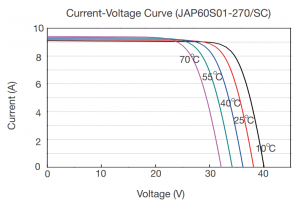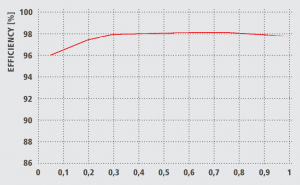This is probably the question that we are most frequently asked, hence the decision to write an article to explain. Surely it would be better if the inverter is rated higher than the total installed capacity of the solar panels? Surely a smaller inverter would be damaged by a larger array of solar panels?
Wrong. It is quite normal and good practice to size an inverter at or below the theoretical peak of the solar array. There are sound reasons for this:
Standard Test Conditions

The rating of a solar panel as quoted on its manufacturer’s data sheet is determined using Standard Test Conditions (STC). This means that the test was performed with a cell temperature of 25°C, an irradiance of 1000 W/m² and an air mass 1.5 (AM1.5) spectrum. Standard Test Conditions allow us to compare solar panels on a level playing field (i.e. conditions in a laboratory), but those conditions do not represent what happens in an installed system.
By the time a solar panel is exposed to a solar irradiance of 1000 W/m² “in the wild” it will easily be well over STC temperature. When exposed to solar irradiance the cells on the solar panels will begin to heat up and will usually get to a temperature at or exceeding 45°C. Solar cells have a temperature coefficient which is usually around -0.45%/°C. This means that it loses 0.45% of its output with every degree warmer it gets, so at 45°C a solar panel will be producing around 9% less than at 25°C. This means that a 250W panel will be producing 225W, or a 300W panel will be down to 273W. Your 4kW system will be producing 3.64kW.
Inverter “undersizing”

Inverter manufacturers quote voltage and current ratings on their data sheets. A Solis 3.6-4G inverter, for example, has a maximum DC voltage of 600V and maximum current of 11A per input. Provided we don’t exceed these maximums in operation we can connect any size of array to the inverter without the risk of damage. If we undersize the inverter too much then we will simply observe ‘clipping’ where the solar panels have the potential to produce more than the inverter can convert to AC, but the inverter limits the output to produce its rated maximum.
The orientation of the solar array is also a factor in our choice of inverter size. In an array on both sides of a house where the two halves of the system are facing in opposite directions, the peak output will be much lower than if all the panels were facing in the same direction. We do, after all, have only have one ball of fire in the sky that can’t be in two places at once. This would also influence our choice of inverter size.
Inverters have an efficiency curve which for most inverters is similar to the one in the graph. At our latitude in the UK, and with our weather, solar arrays spend the majority of their life producing much less than they are capable of. You can see from the graph that the peak efficiency of an inverter is achieved when it is operating at around 70% of its total capacity. If we were to specify too large of an inverter then we actually produce a lower annual yield than that of a more suitably sized model, and in fact would pay more money for the privilege.
Will sizing the inverter this way risk damaging it?
In short, no. The inverter manufacturer will specify a maximum open circuit voltage (Voc) and a maximum input current (Isc) on its product data sheet. The STC figures on the solar panel data sheet (as described above) will need to be adjusted to take into account that in the real world, we don’t operate the array at those temperatures.
Firstly, the Voc: This is led by the temperature. In cold conditions, the Voc of each panel will increase by up to 15%, so we must take the Voc of the string of panels and multiply it by 1.15.
Now the Isc: This is related to irradiance. In very bright conditions the Isc of each panel can exceed the data sheet figure by 25%, so we must multiply it by 1.25.
Provided that these adjusted figures do not exceed the maximums stated by the manufacturer on the inverter data sheet, we can connect an array of any size to the inverter without the risk of damage.
In summary
We are happy to help you select the correct inverter for your array. Over the years we have seen systems with too large or too small an inverter, which would never be able to get the best from the solar panels they’re connected to, and therefore it’s not as simple as “it’s worked for 6 years so it must be OK” (yes, we get that line all the time). If you need any help choosing an inverter from our store then please get in touch.
